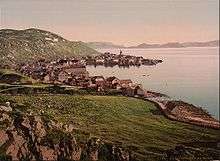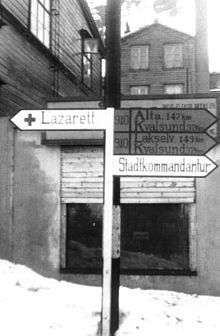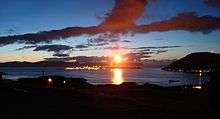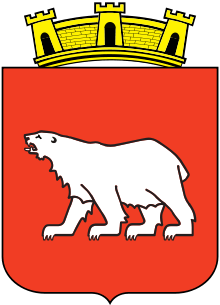Hammerfest
| Hammerfest kommune Hámmárfeastta gielda | |||
|---|---|---|---|
| Municipality | |||
|
Hammerfest in mid-June 2005 | |||
| |||
 Hammerfest within Finnmark | |||
| Coordinates: 70°39′45″N 23°41′00″E / 70.66250°N 23.68333°ECoordinates: 70°39′45″N 23°41′00″E / 70.66250°N 23.68333°E | |||
| Country | Norway | ||
| County | Finnmark | ||
| District | Vest-Finnmark | ||
| Administrative centre | Hammerfest | ||
| Government | |||
| • Mayor (2009) | Alf E. Jakobsen (Ap) | ||
| Area | |||
| • Total | 848.98 km2 (327.79 sq mi) | ||
| • Land | 819.80 km2 (316.53 sq mi) | ||
| • Water | 29.18 km2 (11.27 sq mi) | ||
| Area rank | 129 in Norway | ||
| Population (2014) | |||
| • Total |
10,287 ( | ||
| • Rank | 111 in Norway | ||
| • Density | 12.1/km2 (31/sq mi) | ||
| • Change (10 years) | 12.3 % | ||
| Demonym(s) | Hammerfesting[1] | ||
| Time zone | CET (UTC+1) | ||
| • Summer (DST) | CEST (UTC+2) | ||
| ISO 3166 code | NO-2004 | ||
| Official language form | Neutral | ||
| Website |
www | ||
|
| |||
![]() Hammerfest (Northern Sami: Hámmárfeasta) is a municipality in Finnmark county, Norway. The administrative centre of the municipality is the town of Hammerfest. Some of the main villages in the municipality include Rypefjord, Forsøl, Hønsebybotn, Akkarfjord, Akkarfjord, and Kårhamn.
Hammerfest (Northern Sami: Hámmárfeasta) is a municipality in Finnmark county, Norway. The administrative centre of the municipality is the town of Hammerfest. Some of the main villages in the municipality include Rypefjord, Forsøl, Hønsebybotn, Akkarfjord, Akkarfjord, and Kårhamn.
The municipality encompasses parts of three large islands: Kvaløya, Sørøya, and Seiland. Other small islands such as Lille Kamøya and Kamøya are also located here. Most of the municipality does not have a road connection with the rest of Norway. Only Kvaløya island is connected via the Kvalsund Bridge.
General information
The municipality called Hammerfest by og landdistrikt was established on 1 January 1838 (see formannskapsdistrikt). It included the town of Hammerfest and the vast rural district surrounding it. The law required that all towns should be separated from their rural districts, but because of low population, and very few voters, this was impossible to carry out for Hammerfest in 1838. (See also: the towns of Vadsø and Vardø.) Eventually, on 1 January 1852, the rural district was separated from the town of Hammerfest to form the new municipality of Hammerfest landdistrikt (later renamed Sørøysund). The northern district of Maasø was separated in 1839, and the southern district of Kvalsund was separated in 1869. On 1 January 1992, the municipality of Sørøysund was merged with the town of Hammerfest to form a new, larger municipality of Hammerfest.[2]
Name
The municipality is named after the town that was established in 1789. The town was named after an old anchorage. The first element is hammer, referring to a number of large rocks, good for mooring boats, called Hamran (Old Norse: Hamarr meaning "steep mountainside"). The Hamran were covered up in land reclaiming during the early post-war years. The last element is fest, from Old Norse festr which means "fastening" (for boats).[3]
Coat-of-arms
The coat-of-arms is from relatively recent times. They were granted on 16 December 1938. The arms of Hammerfest, a polar bear on a red background, were prepared for the celebration of the 150th anniversary of the town's foundation in 1939. The polar bear was chosen as a symbol for the fishing in the polar seas north of Norway. The polar bear itself is not native to mainland Norway.[4][5]
Churches
The Church of Norway has one parish (sokn) within the municipality of Hammerfest. It is part of the Hammerfest deanery in the Diocese of Nord-Hålogaland.
| Parish (Sokn) | Church Name | Location of the Church | Year Built |
|---|---|---|---|
| Hammerfest | Hammerfest Church | Hammerfest | 1961 |
History
Many grave sites dating back to the Stone Age can be found here. This location was an important fishing and Arctic hunting settlement for a long time before it was given market town rights by royal decree of Christian VII of Denmark–Norway in 1789.
Napoleonic Wars
During the Napoleonic Wars, Denmark–Norway was attacked by Great Britain and forced into the conflict on the side of Napoleon and France. As one of the main centres of commerce and transportation in western Finnmark, Hammerfest became a natural target of the Royal Navy's blockading warships. Thus, on the request of local merchants, the town received four six-pound cannon from the central armoury in Trondheim. Subsequently, a 50-man strong coastal defence militia was formed to defend Hammerfest. A number of merchants formed the officer corps of the militia, while Sea Samis and Kvens were mobilized as gun crews and soldiers.
British attack
On 22 July 1809, the expected British attack came when the brigs Snake and Fancy approached the town. Before reaching Hammerfest, the British vessels had looted the village of Hasvik, laying waste to the small fishing community. The following battle between Hammerfest's two two-cannon batteries and the British warships with a total of 32 cannon was surprisingly intense and did not end before the Norwegian cannons had run out of gunpowder after about 90 minutes of combat. Both attacking warships had suffered a number of cannonball hits and had at least one fatal casualty; a sailor who was buried at the local cemetery. During the battle, the local populace had been able to escape with most of the town's goods, but the raiding warships still stayed in the good port of Hammerfest for eight days. During their stay the Royal Navy sailors looted all they could get their hands on, including the church donation box and some of the church's silver.
Improved fortifications
After the raid, Hammerfest became a garrison town with some regular troops and much improved and expanded fortifications. A small flotilla of cannon-armed rowing boats also operated out of Hammerfest for the remainder of the Napoleonic Wars.

_aus_100_m_H%C3%B6he-Spitzbergenflug_1923-LBS_MH02-01-0058-AL-FL.tif.jpg)
Fire of 1890
Hammerfest was struck by a fire in 1890 which started in the bakery and wiped out almost half the town's houses. After the fire Hammerfest received donations and humanitarian assistance from across the world, with the biggest single donor being Kaiser Wilhelm II of Germany. The Kaiser had personally visited the town several times on his yacht and had great affection for the small northern settlement.
Electric street lighting
In 1891, Hammerfest became the first urban settlement in Northern Europe to get electrical street lights. The invention was brought to Hammerfest by two of the town's merchants who had seen it demonstrated at a fair in Paris.
Destruction in the Second World War


After their victory in the Norwegian Campaign of the Second World War, the Germans soon fortified Hammerfest and used it as a major base. The importance of Hammerfest to the Germans increased dramatically after their invasion of the Soviet Union in 1941. The occupiers installed three coastal batteries in and around Hammerfest, one with four 10.5 cm (4.1 in) guns on Melkøya island near the town, one with three 10.5 cm guns on a hill right outside the town and a final battery with casemated 13 cm (5.1 in) pieces on the Rypklubben peninsula near Rypefjord.
The main German U-boat base in Finnmark was in Hammerfest, serving as a central supply base for the vessels attacking the allied supply convoys to Russia.[6] Luftwaffe seaplanes were based at an improvised naval air station in nearby Rypefjord.[7] The garrison in Hammerfest was also protected by around 4,000 mines and numerous anti-aircraft guns.
During their long retreat following the Petsamo-Kirkenes Operation, the Germans no longer managed to transport troops by sea further east due to intensive Red Air Force raids. Thus Hammerfest became their main shipping port in Finnmark in the autumn of 1944.[8]
Hammerfest was bombed twice by the Soviet Air Forces; on 14 February 1944 with little damage and again on 29 August 1944 with more significant damage to buildings and infrastructure and with ships sunk in the harbour.[9] The ships lost were the local transports Tanahorn and Brynilen.[10][11]
The population was forcibly evacuated by the occupying German troops in the autumn of 1944 after a Soviet offensive at the northern extremity of the Eastern Front pushed into eastern Finnmark. All of Finnmark including the town was looted and burned to the ground by the Germans when they retreated in 1945, the last of the town having been destroyed by the time the Germans finally left on 10 February 1945. Only the town's small funeral chapel, built in 1937, was left standing.[9] The Museum of Reconstruction in Hammerfest tells the story of these events and the recovery of the region. The Soviet troops in eastern Finnmark were withdrawn in September 1945.
Mines and munitions left over from the Second World War are still being found and disposed of in the Hammerfest area.[12]
Geography
The island municipality encompasses parts of three large islands: Kvaløya, Sørøya, and Seiland. Other small islands such as Lille Kamøya and Kamøya are also located here. Seiland National Park is partially located in the municipality. Seilandsjøkelen is a large glacier in the park. The Nordefjorden is a fjord that is part of the park. The mountains Komagaksla and Seilandstuva are some of the largest mountains in the municipality.
Hammerfest claims to be the northernmost city in the world, although the title is disputed by Honningsvåg, Norway (achieved town status 1996). The validity of the claim depends upon one's definition of a city; although Hammerfest is further south than Honningsvåg it has a population over 5,000, which is required by Norwegian law to achieve town status (law from 1997). In retrospect, Parliament ruled that a city should be located in a municipality with at least 5,000 inhabitants. But the provision has not been made retroactive. Honningsvåg is the northernmost town today, in Norway.[13] Barrow, Alaska, population c. 4,000, is further north than both the Norwegian towns, but does not lay claim to the title of northernmost town.[14] Some foreigners may find it strange that either Hammerfest or Honningsvåg claims to be cities, given the small size of both places and it may help to know that the Norwegian language does not distinguish between city and town. The closest translation for either term is the word by, meaning the translation from Norwegian to English is ambiguous. If both Hammerfest and Honningsvåg were to be defined according to old British tradition, neither of them would be considered cities, as neither has a cathedral. Both of them may, however, be considered towns, given the status of both settlements as economic hubs of the surrounding areas and the status as municipal centres.
Hammerfest is, together with Vardø, the oldest town in Northern Norway. The town of Hammerfest is situated on the island of Kvaløya, with road connection to the mainland using the Kvalsund Bridge.
Climate
In spite of the extreme northern location, there is no permafrost, as the mean annual temperature is approximately 2 °C (36 °F), about the same as Anchorage, Alaska which is located at a latitude of 61° North. Monthly 24-hr averages range from −5 °C (23 °F) in January to 11 °C (52 °F) in July. Mean annual precipitation is 820 millimetres (32.3 in). The driest months are May, June, and July; with on average of 50 millimetres (2.0 in) of rainfall each month. The wettest period is October through December.[15]
Hammerfest often experiences heavy snowfall in winter, and on some occasions, avalanches or risk of avalanches have forced some inhabitants to be evacuated from their exposed homes until the danger was over.[16]
During the summer, there is continuous daylight, while during winter, the sun does not rise above the horizon.
| Climate data for Hammerfest 1961-1990 | |||||||||||||
|---|---|---|---|---|---|---|---|---|---|---|---|---|---|
| Month | Jan | Feb | Mar | Apr | May | Jun | Jul | Aug | Sep | Oct | Nov | Dec | Year |
| Record high °C (°F) | 8.0 (46.4) |
7.7 (45.9) |
7.5 (45.5) |
11.5 (52.7) |
23.4 (74.1) |
27.9 (82.2) |
29.7 (85.5) |
26.6 (79.9) |
19.4 (66.9) |
14.8 (58.6) |
10.0 (50) |
9.1 (48.4) |
29.7 (85.5) |
| Average high °C (°F) | −2.2 (28) |
−2.1 (28.2) |
−1.0 (30.2) |
1.3 (34.3) |
5.6 (42.1) |
11.0 (51.8) |
14.7 (58.5) |
13.3 (55.9) |
8.8 (47.8) |
4.1 (39.4) |
0.9 (33.6) |
−1.1 (30) |
4.44 (39.98) |
| Daily mean °C (°F) | −5.2 (22.6) |
−5.0 (23) |
−3.7 (25.3) |
−1.0 (30.2) |
3.2 (37.8) |
7.8 (46) |
11.3 (52.3) |
10.5 (50.9) |
6.6 (43.9) |
2.0 (35.6) |
−1.6 (29.1) |
−3.8 (25.2) |
1.76 (35.16) |
| Average low °C (°F) | −8.9 (16) |
−8.8 (16.2) |
−7.2 (19) |
−4.3 (24.3) |
0.4 (32.7) |
5.2 (41.4) |
8.5 (47.3) |
7.8 (46) |
4.1 (39.4) |
−0.6 (30.9) |
−4.4 (24.1) |
−7.1 (19.2) |
−1.28 (29.71) |
| Record low °C (°F) | −23.5 (−10.3) |
−23.0 (−9.4) |
−21.0 (−5.8) |
−16.5 (2.3) |
−14.3 (6.3) |
−4.3 (24.3) |
2.5 (36.5) |
0.0 (32) |
−8.2 (17.2) |
−15.0 (5) |
−18.1 (−0.6) |
−20.4 (−4.7) |
−23.5 (−10.3) |
| Average precipitation mm (inches) | 71 (2.8) |
65 (2.56) |
62 (2.44) |
60 (2.36) |
47 (1.85) |
52 (2.05) |
56 (2.2) |
60 (2.36) |
79 (3.11) |
93 (3.66) |
85 (3.35) |
90 (3.54) |
820 (32.28) |
| Source: http://eklima.met.no/ | |||||||||||||
Government
All municipalities in Norway, including Hammerfest, are responsible for primary education (through 10th grade), outpatient health services, senior citizen services, unemployment and other social services, zoning, economic development, and municipal roads. The municipality is governed by a municipal council of elected representatives, which in turn elect a mayor.
Municipal council
The municipal council (Kommunestyre) of Hammerfest is made up of 29 representatives that are elected to every four years. Currently, the party breakdown is as follows:[17]
| Party Name | Name in Norwegian | Number of representatives | |
|---|---|---|---|
| Labour Party | Arbeiderpartiet | 20 | |
| Progress Party | Fremskrittspartiet | 1 | |
| Conservative Party | Høyre | 3 | |
| Christian Democratic Party | Kristelig Folkeparti | 1 | |
| Green Party | Miljøpartiet De Grønne | 1 | |
| Socialist Left Party | Sosialistisk Venstreparti | 3 | |
| Total number of members: | 29 | ||
Economy and tourism

The construction of the large liquefied natural gas site on Melkøya (island) just off Hammerfest, which will process natural gas from Snøhvit, is the most expensive construction project in the history of Northern Norway. This project has resulted in an economic boom and new optimism in Hammerfest in recent years, a stark contrast to the economic downhill and negative population growth most other municipalities in Finnmark are experiencing.[18][19][20][21] After the opening of natural gas production on Melkøya there have been some problems with significant smoke and soot pollution in the initial production phases.[22] Snøhvit is Europe's first export facility for liquefied natural gas.[23]

Hammerfest offers sport and commercial fishing, both sea and freshwater, as well as scuba diving. The northernmost glacier on the Norwegian mainland is a popular hiking destination. The town is a popular starting point for northern tours. There is a daily boat to the North Cape (Norwegian: Nordkapp). One chain of the Struve Geodetic Arc, now on the World Heritage List, is located at Fuglenes in Hammerfest.
Hammerfest is also a centre of Sami culture. Hammerfest is home to the Royal and Ancient Polar Bear Society (Norwegian: Isbjørnklubben); a museum displaying the history of Arctic hunting.
The newspaper Hammerfestingen is published in Hammerfest.
American author Bill Bryson begins his European travels in 1990, documented in his popular book Neither Here Nor There, with a visit to Hammerfest in order to see the Northern Lights, calling it “an agreeable enough town in a thank-you-God-for-not-making-me-live-here sort of way”.[24]
Transportation
Hammerfest is connected to the main road network by Norwegian national road 94 which branches off from European route E6 at Skaidi in the neighbouring municipality of Kvalsund. The town is a port of call for the Hurtigruten ship route. Hammerfest also has Finnmark's third largest airport, Hammerfest Airport, opened 30 July 1974. Before the opening of the airport, the only air link to Hammerfest was by seaplane, the first route established in 1936.[25]
Reindeer issues

During the summer, massive reindeer herds migrate from their winter pastures in the inner parts of Finnmark to the coast. Among the islands inhabited by reindeer during the summer months is Kvaløya, the island on which Hammerfest town is located. For years many of the 2,500 to 3,000 reindeer in the area have been coming into the town itself, wandering in the streets and among the houses. Although very popular with tourists, this has been less favourably received by the town's population, with people complaining of traffic disturbances and the dung and urine left by the animals. For hygienic reasons large sums of money have to be spent every year to clean up after the animals.[26] In response to the complaints the town authorities built a 20-kilometre-long (12 mi), 1.2-metre-tall (4 ft) fence encircling the town to keep the animals out.[27] However, as of the 2008 reindeer season, the fence had proven ineffective, with reindeer managing to pass through on road crossings, despite the presence of electrified grates embedded in the ground.[28] The problem continues – the mayor, Alf E. Jakobsen, joked during the local election in 2011 that he was contemplating a career as a reindeer herder if he lost the vote.[29]
International relations
Twin towns — Sister cities
.jpg)
Hammerfest is town twinned with the following foreign settlements:
 – Haparanda, Sweden [30]
– Haparanda, Sweden [30] – Ikast, Denmark [31]
– Ikast, Denmark [31] – Kola, Russia [32]
– Kola, Russia [32] – Mokpo, South Korea[33]
– Mokpo, South Korea[33] – Petersburg, Alaska, United States [34]
– Petersburg, Alaska, United States [34] – Tornio, Finland [35]
– Tornio, Finland [35] – Trelleborg, Sweden [31]
– Trelleborg, Sweden [31] – Ushuaia, Argentina
– Ushuaia, Argentina
Foreign consulates
Denmark,[36] Sweden,[37] Finland[38] and the Netherlands[39] have honorary consulates in Hammerfest.
References
- ↑ "Navn på steder og personer: Innbyggjarnamn" (in Norwegian). Språkrådet. Retrieved 2015-12-01.
- ↑ Jukvam, Dag (1999). "Historisk oversikt over endringer i kommune- og fylkesinndelingen" (PDF) (in Norwegian). Statistisk sentralbyrå.
- ↑ Kortner, Olaf; et al. (1993). Aschehoug og Gyldendals store norske leksikon (in Norwegian). 6. Oslo: Kunnskapsforlaget. p. 354. ISBN 82-573-0581-2.
- ↑ "Kommunevåpen". Flags of the World. 30 April 2002. Retrieved 2008-12-10. External link in
|publisher=(help) - ↑ Norske Kommunevåpen (1990). "Nye kommunevåbener i Norden". Retrieved 2008-12-10.
- ↑ Knudsen, Svein Aage (2006). Ubåtkrig - tyske ubåtmannskaper i norske farvann 1940-1945 (in Norwegian). Arendal: DANOR Forlag AS. p. 133.
- ↑ Hafsten, Bjørn; Larsstuvold, Ulf; Olsen, Bjørn; Stenersen, Sten (1991). Flyalarm - luftkrigen over Norge 1939-1945 (in Norwegian) (1st ed.). Oslo: Sem og Stenersen. p. 319. ISBN 82-7046-058-3.
- ↑ Gamst, Thorbein (1984). Finnmark under Hakekorset - Festung Finnmark (in Norwegian). Arendal: Agdin Forlag. pp. 137–141.
- 1 2 Ringdal, Nils Johan (1995). "Hammerfest". In Dahl; Hjeltnes; Nøkleby; Ringdal; Sørensen. Norsk krigsleksikon 1940-45 (in Norwegian). Oslo: Cappelen. p. 153. ISBN 82-02-14138-9. Retrieved 27 January 2010.
- ↑ Lawson, Siri Holm. "D/S Tanahorn". Warsailors.com. Retrieved 27 January 2010.
- ↑ Lawson, Siri Holm. "M/S Brynilen". Warsailors.com. Retrieved 27 January 2010.
- ↑ "Tysk mine på 300 kilo sprengt". Finnmark Dagblad (in Norwegian).
- ↑ Byer i Norge (in Norwegian). http://www.kommunal-rapport.no/artikkel/byer_i_norge
- ↑ Mellgren, Doug (Associated Press) (March 19, 1998). "It's a matter of latitude: Norwegians trade barbs in northernmost-town spat". Seattle Post-Intelligencer. Retrieved March 16, 2010.
- ↑ "Hammerfest" (in Norwegian). Norwegian Meteorological Institute.
- ↑ "Avalanches in Norway" (in Norwegian). Norwegian Geotechnical Institute.
- ↑ "Table: 04813: Members of the local councils, by party/electoral list at the Municipal Council election (M)" (in Norwegian). Statistics Norway. 2015. Archived from the original on 2016-03-06.
- ↑ Blask, Sarah (4 December 2007). "Boomtown on the Barents". The Smart Set.
- ↑ Mouawad, Jad (9 October 2007). "A Quest for Energy in the Globe’s Remote Places". The New York Times. Retrieved 4 May 2010.
- ↑ Krauss, Clifford (10 October 2005). "As Polar Ice Turns to Water, Dreams of Treasure Abound". The New York Times. Retrieved 4 May 2010.
- ↑ Duval-Smith, Alex (27 November 2005). "Arctic booms as climate change melts polar ice cap". The Observer. London.
- ↑ Berglund, Nina (31 August 2007). "'Snow White' opening clouded by soot over Hammerfest". Aftenposten.
- ↑ "Scheduled shutdown on Snoehvit". The Norway Post. 6 October 2008. Retrieved 2008-10-06.
- ↑ Bryson, Bill. Neither Here Nor There: Travels in Europe. ISBN 978-0-552-99806-2.
- ↑ "North to Hammerfest". Time Magazine. 8 June 1936.
- ↑ Fouché, Gwladys (26 June 2006). "The rampaging reindeer of Hammerfest". The Guardian. London.
- ↑ Purvis, Andrew (25 September 2007). "Reindeer Games in Norway". Time Magazine.
- ↑ Palm, Eirik (2 May 2008). "1-0 til Rudolf". Finnmark Dagblad (in Norwegian).
- ↑ "Reindeers still visiting town in 2011".
- ↑ "Cities in the counties of Norrbotten and Västerbotten and their twin-cities in Finland, Norway and Russia" (PDF). The Barents portal. April 2004. Archived from the original (PDF) on March 9, 2006. Retrieved 2008-12-08.
- 1 2 "Vennskapsamarbeid" (in Norwegian). Norden.no.
- ↑ "Welcome to Kola village". Kola Travel. Retrieved 8 December 2008.
- ↑ Hammerfest, Norway
- ↑ "Alaska's Sister States & Sister Cities". Gov.state.ak.
- ↑ "Tornio Twin Cities". Tornio.fi.
- ↑ "Danish consulates in Norway, A-K" (in Danish). Ministry of Foreign Affairs of Denmark.
- ↑ "Honorary Consulate of Sweden, Hammerfest". Government Offices of Sweden.
- ↑ "Finland´s Honorary Consulate, Hammerfest". Ministry for Foreign Affairs of Finland.
- ↑ "Dutch Consulate in Hammerfest, Norway". Embassies/Consulates in Norway.
| Wikimedia Commons has media related to Hammerfest municipality. |
External links
- Webcam Hammerfest
 Hammerfest travel guide from Wikivoyage
Hammerfest travel guide from Wikivoyage- Information from Statoil about the Snøhvit LNG construction
- Tromsø University Museum: Maritime hunter - fishers through 10,000 years at Melkøya
- Hammerfest official tourist information
- Finnmark University College
- Arctic booms as climate change melts polar ice cap
- Power station using tidal current as energy in Kvalsund
- New oil field discovered only 45 km (28 mi) off the coast
- Goliat oil field larger than previously thought
- Information about the planned natural gas power plant with CO2 reduction (in Norwegian)


